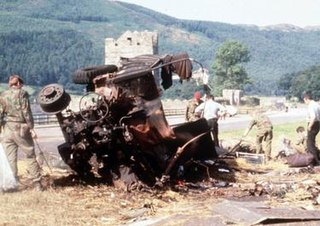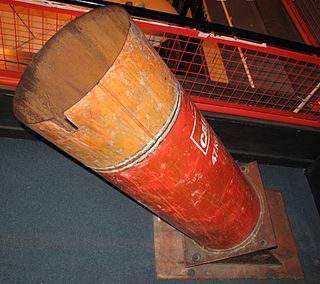This is a chronology of activities by the Provisional Irish Republican Army (IRA) from 1970 to 1979.

The South Armagh Brigade of the Provisional Irish Republican Army (IRA) operated during the Troubles in south County Armagh. It was organised into two battalions, one around Jonesborough and another around Crossmaglen. By the 1990s, the South Armagh Brigade was thought to consist of about 40 members, roughly half of them living south of the border. It has allegedly been commanded since the 1970s by Thomas 'Slab' Murphy who is also alleged to be a member of the IRA's Army Council. Compared to other brigades, the South Armagh IRA was seen as an 'independent republic' within the republican movement, retaining a battalion organizational structure and not adopting the cell structure the rest of the IRA was forced to adopt after repeated intelligence failures.

The Warrenpoint ambush, also known as the Narrow Water ambush, the Warrenpoint massacre or the Narrow Water massacre, was a guerrilla attack by the Provisional Irish Republican Army (IRA) on 27 August 1979. The IRA's South Armagh Brigade ambushed a British Army convoy with two large roadside bombs at Narrow Water Castle outside Warrenpoint, Northern Ireland. The first bomb was aimed at the convoy itself, and the second targeted the incoming reinforcements and the incident command point (ICP) set up to deal with the incident. IRA volunteers hidden in nearby woodland also allegedly fired on the troops, who returned fire. The castle is on the banks of the Newry River, which marks the border between Northern Ireland and the Republic of Ireland.
Michael McVerry, was a Provisional Irish Republican Army volunteer and Officer Commanding of the First Battalion of the Provisional IRA South Armagh Brigade. He was killed in Keady in 1973.
The Troubles in Crossmaglen recounts incidents during, and the effects of, the Troubles in Crossmaglen, County Armagh, Northern Ireland.
The Troubles in Forkhill recounts incidents during, and the effects of, the Troubles in Forkhill, County Armagh, Northern Ireland.

Barrack buster is the colloquial name given to several improvised mortars, developed in the 1990s by the engineering unit of the Provisional Irish Republican Army (IRA).
Bernard Henry McGinn was a Provisional Irish Republican Army (IRA) volunteer who was sentenced to a total of 490 years' imprisonment in 1999. He was released in 2000 under the terms of the Good Friday Agreement.
The Glasdrumman ambush was an attack by the South Armagh Brigade of the Provisional Irish Republican Army (IRA) against a British Army observation post in Glasdrumman, County Armagh on 17 July 1981. An attempted ambush by the British Army on IRA members at a scrapyard southwest of Crossmaglen was itself ambushed, resulting in the death of one British soldier and the IRA retaining the ability to set up checkpoints in South Armagh.

The Drummuckavall ambush was an attack by the South Armagh Brigade of the Provisional Irish Republican Army (IRA) on a British Army observation post in Drummuckavall, southeast of Crossmaglen, County Armagh, on 22 November 1975. The attack, which occurred along the border with the Republic of Ireland, resulted in the deaths of three British soldiers and underlined the inefficiency of conventional military skills to deal with the situation in South Armagh, prompting the deployment of the Special Air Service (SAS) in this area.

The South Armagh Sniper is the generic name given to the members of the Provisional Irish Republican Army's (IRA) South Armagh Brigade who conducted a sniping campaign against the British Army from 1990 to 1997. The campaign is notable for the snipers' use of .50 BMG calibre Barrett M82 and M90 long-range rifles in some of the shootings.

On 19 March 1994, a British Army Lynx helicopter was shot down by the Provisional Irish Republican Army (IRA) in Northern Ireland. A unit of the IRA's South Armagh Brigade fired a heavy improvised mortar at the British Army base in Crossmaglen, County Armagh. The mortar round hit and shot down the helicopter, serial number ZD275, while it was hovering over the helipad. Three British soldiers and a Royal Ulster Constabulary (RUC) member were wounded.

The occupation of Cullaville took place on 22 April 1993, when 12 armed members of the South Armagh Brigade of the Provisional Irish Republican Army (IRA) set up a checkpoint on the main crossroads of Cullaville, County Armagh, Northern Ireland, isolating the small village for a two-hour period, despite the presence of a British Army watchtower some yards away. The IRA men withdrew before the security forces in the area could react.

The Battle of Newry Road was a running gun battle between British Army helicopters and Provisional Irish Republican Army (IRA) armed trucks, fought along the lanes east of Crossmaglen, County Armagh, on 23 September 1993. The engagement began when an IRA motorized team from the South Armagh Brigade attempted to ambush three helicopters lifting off from the British Army base at Crossmaglen, one of them carrying the 3rd Infantry Brigade Commander.

On 27 August 1975 a Provisional Irish Republican Army bomb exploded without warning at the Caterham Arms public house in Caterham, Surrey, England. There were no fatalities, but 33 people were injured, some severely, including three off-duty soldiers who lost limbs.
On 11 August 1970, two Royal Ulster Constabulary (RUC) officers were killed by a booby-trap bomb planted under a car by the Provisional Irish Republican Army (IRA) near Crossmaglen, in County Armagh, Northern Ireland. They were the first RUC officers to be killed by republicans during the Troubles and the first security forces to be killed in South Armagh, an IRA stronghold for much of the conflict.

On 23 June 1988, an Army Air Corps (AAC) Westland Lynx, serial number XZ664, was shot down by the Provisional Irish Republican Army (IRA) near Aughanduff Mountain, County Armagh, in Northern Ireland. A unit of the IRA's South Armagh Brigade fired at the British Army helicopter using automatic rifles and heavy machine guns. The disabled helicopter was forced to crash-land in an open field; the aircraft and its crew were eventually recovered by British forces.

Throughout the protracted conflict in Northern Ireland (1960s-1998), the Provisional IRA developed a series of improvised mortars to attack British Army and Royal Ulster Constabulary (RUC) security bases. The organisation also purchased both light and heavy machine guns in order to hamper the British Army supply of border bases by helicopter. The IRA fitted vehicles, specially vans and trucks, with both types of weapons. Vans, trucks and tractors were modified to transport concealed improvised mortars to a launch area near the intended target and fire them, while light and heavy trucks were employed as firing platforms mounting machine guns, particularly M60s and DShKs. Improvised armoured vehicles and heavy equipment were also used to penetrate the perimeter of fortified security bases. The IRA vehicles were often disguised as belonging to civilian companies or even government agencies.
On 24 June 1972, in the rural townland of Crabarkey near Dungiven, the Provisional IRA detonated an improvised land mine, killing three British Army soldiers in a Land Rover. It was one of many such landmine attacks by the IRA in rural areas in the 1970s.










